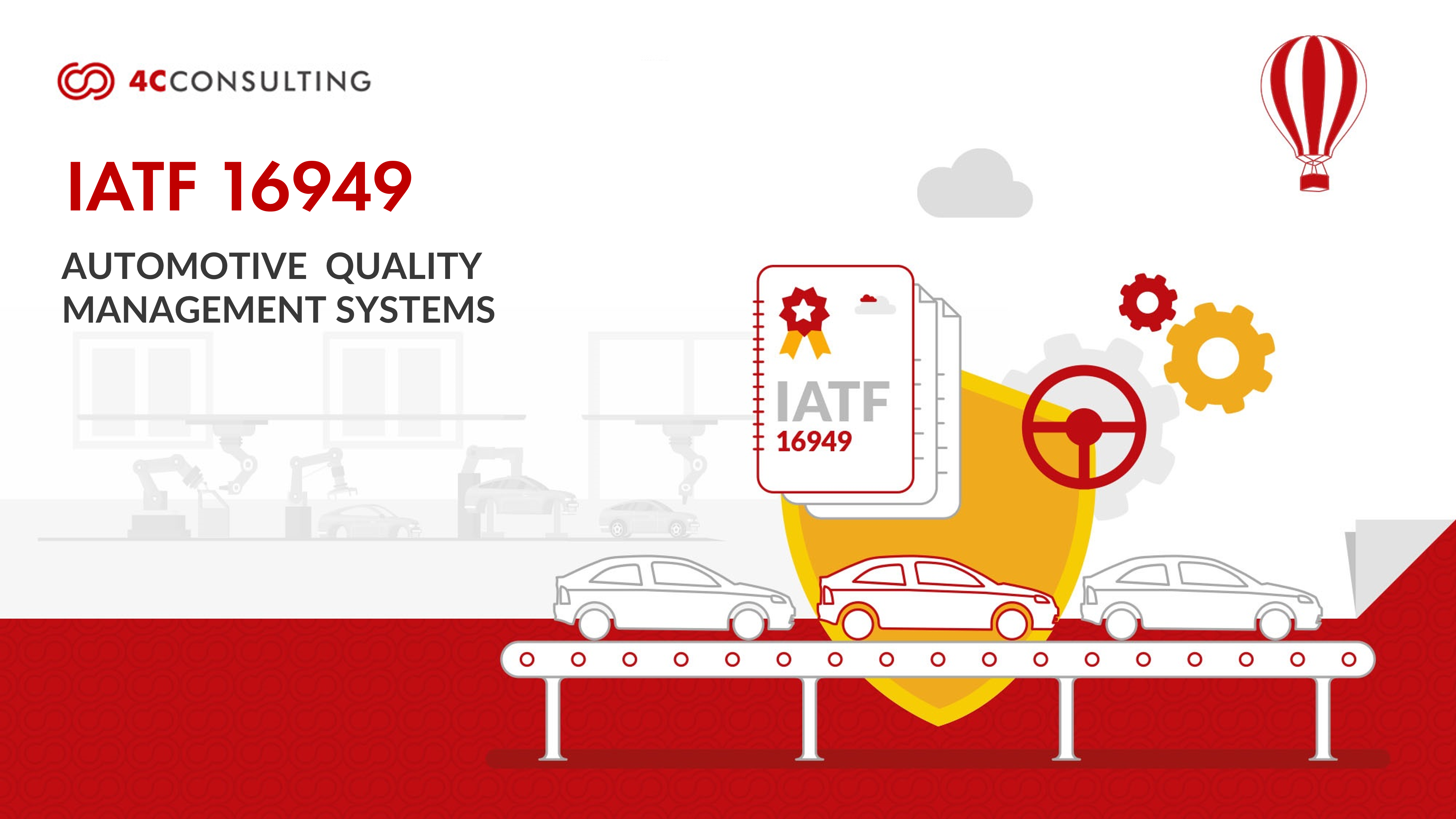
Automotive Excellence: Understanding IATF 16949 Clauses and Essential Requirements
15th Feb, 2024
In the dynamic realm of automotive manufacturing, precision and quality are fundamental pillars. This blog serves as a guide through the intricate framework of IATF 16949, a bespoke standard tailored for automotive excellence. Whether you’re a seasoned professional or a newcomer to the industry, join us as we unveil the essential clauses and requirements of IATF 16949. Our commitment is to provide insights that not only meet industry benchmarks but also direct you toward automotive excellence. Let’s explore how these standards not only align but consistently exceed the expectations of an industry that demands nothing short of perfection. IATF 16949 is the key to achieving outstanding Automotive Excellence for those who understand and navigate its details.
.
Why IATF 16949 is required?
IATF 16949 is a globally accepted standard for automotive excellence and is essential for several compelling reasons for elevating the quality and efficiency of automotive manufacturing. The major reasons include:
- Industry Alignment: IATF 16949 is tailored for the automotive sector, offering a standardized quality approach globally accepted within the automotive supply chain.
- Customer Expectations: Many automotive OEMs and key customers require IATF 16949 certification as a prerequisite for engaging in automotive business.
- Global Recognition: IATF 16949 facilitates international trade by establishing a common language and expectations for quality management in the automotive industry.
- Risk Management: The standard prioritizes risk management, identifying and addressing potential risks to prevent defects and enhance operational efficiency.
- Continuous Improvement: Embracing the PDCA cycle, IATF 16949 nurtures continual improvement, enabling organizations to remain competitive and adapt to changing customer demands.
- Cost Reduction: Implementation of IATF 16949 often leads to cost reductions through improved efficiency, reduced defects, and strengthened supplier relationships.
- Supply Chain Management: The standard emphasizes effective supply chain management and the control of externally provided processes, ensuring quality and reliability.
- Customer Satisfaction: IATF 16949 aims to enhance customer satisfaction by ensuring products consistently meet requirements, minimizing defects and recalls, and fostering trust.
.
What is IATF 16949 Standard?
IATF 16949 is a quality management standard designed for the automotive industry developed collaboratively by the International Automotive Task Force and ISO (International Organization for Standardization), it offers a robust framework for organizations to improve their Quality Management Systems (QMS). Operating within the PDCA (Plan-Do-Check-Act) cycle, IATF 16949 ensures systematic planning, execution, monitoring, and evaluation of processes, facilitating continuous improvement.
More than a certification, IATF 16949 serves as a crucial roadmap for organizations to meet industry benchmarks, streamline operations, and navigate the complexities of the automotive supply chain. It is essential for organizations committed to achieving and sustaining Automotive Excellence in the competitive landscape of automotive manufacturing.
.
What are the IATF 16949 Clauses?
The implementation of ISO 9001:2015 follows a structured framework that progresses through distinct stages, each with its set of clauses and critical sub-clauses. Let’s delve into the essence of each stage, shedding light on the clauses and the pivotal sub-clauses or bullets that shape the Quality Management System (QMS).
A. Plan: Setting the Foundation
Clause 4: Context of the organization
- Understanding The Organization And Its Context: This involves identifying internal and external factors that may impact the QMS.
- Understanding The Needs And Expectations Of Interested Parties: Organizations need to comprehend the expectations and requirements of stakeholders.
- Determining The Scope Of The Quality Management System: Clearly defining the boundaries and applicability of the QMS.
- Quality Management System And Its Processes: Establishing and maintaining the QMS, ensuring its effectiveness.
.
Clause 5: Leadership
- Leadership And Commitment: Top management demonstrates leadership and commitment to the QMS.
- Policy: Developing a quality policy aligned with organizational goals.
- Organizational Roles, Responsibilities, And Authorities: Defining roles and responsibilities to ensure effective QMS implementation.
.
B. Do: Putting Plans into Action
Clause 6: Planning
- Actions To Address Risks And Opportunities: Identifying and addressing potential risks and opportunities.
- Quality Objectives And Planning To Achieve Them: Establishing measurable quality objectives.
- Planning Of Changes: Systematically planning changes to the QMS.
.
C. Check: Verifying and Monitoring
Clause 8: Operation
- Operational Planning And Control: Planning and controlling operational processes.
- Requirements For Products And Services: Ensuring products and services meet customer requirements.
- Design And Development Of Products And Services: Managing the design and development processes.
- Control Of Externally Provided Processes, Products, And Services: Ensuring control over external processes and products.
- Production And Service Provision: Controlling the production and delivery of products and services.
- Release Of Products And Services: Ensuring products and services meet requirements before release.
- Control Of Nonconforming Outputs: Addressing nonconforming products or services.
.
Clause 9: Performance Evaluation
- Monitoring, Measurement, Analysis, And Evaluation: Establishing a systematic process for monitoring and evaluating QMS performance.
- Internal Audit: Conducting internal audits to ensure compliance.
- Management Review: Top management reviews the QMS for effectiveness.
.
D. Act: Learning and Adapting
Clause 10: Improvement
- Continual Improvement: Fostering a culture of ongoing improvement.
- Corrective Actions: Taking corrective actions when nonconformities are identified.
- Nonconformity And Corrective Actions: Documenting and addressing nonconformities.
.
What are the requirements of IATF 16949 Standard?
Apart from the clauses, IATF 16949 standard has specific requirements that organizations must fulfil to achieve and maintain certification.
Some of these additional requirements include:
- Customer-Specific Requirements (CSRs): Organizations are required to identify, understand, and meet customer-specific requirements, ensuring compliance with the expectations and specifications of automotive customers.
- Core Tools Implementation: IATF 16949 emphasizes the use of core quality management tools such as Advanced Product Quality Planning (APQP), Production Part Approval Process (PPAP), Failure Mode and Effects Analysis (FMEA), Measurement System Analysis (MSA), and Statistical Process Control (SPC).
- Product Safety: Organizations must address product safety concerns, including the identification and compliance with applicable legal and regulatory requirements related to the safety of automotive products.
- Second-Party Audits: Organizations may be subject to second-party audits conducted by customers or other external parties to verify compliance with IATF 16949 requirements.
- Control Plans: Organizations are required to develop and maintain control plans to ensure effective control of manufacturing processes and products.
- Change Management: Robust processes for change management must be established to control and document changes to products, processes, or the quality management system.
- Warranty Management: Organizations need to have processes in place for warranty management, including monitoring, analyzing, and addressing warranty claims and returns.
- Sub-tier Supplier Management: Effective management of sub-tier suppliers is essential, ensuring that lower-tier suppliers meet the necessary quality and process requirements.
- Contingency Plans: Organizations must establish contingency plans to address potential disruptions in the supply chain or manufacturing processes.
- Ethical Behavior: IATF 16949 emphasizes the importance of ethical behavior and requires organizations to uphold high standards of business conduct and integrity.
.
What are the benefits of IATF 16949 Certification Standard?
Implementing the IATF 16949 standard brings various advantages for organizations operating in the automotive sector ensuring compliance with industry-specific requirements but also fosters a culture of excellence and continual improvement. Let’s explore the additional benefits that organizations adhering to the IATF 16949 standard can experience –
- Legal Compliance: IATF 16949 ensures that organizations stay compliant with relevant legal and regulatory requirements in the automotive industry, reducing the risk of non-compliance and associated penalties.
- Faster Time-to-Market: Efficient processes and robust quality management contribute to faster development cycles, enabling quicker time-to-market for new products.
- Innovation: The focus on continual improvement encourages innovation within the organization, fostering a culture of creativity and adaptability.
- Reduced Variability: IATF 16949 helps minimize process variations, ensuring consistent quality in products and services.
- Effective Communication: The standard emphasizes clear communication within the organization and throughout the supply chain, reducing the likelihood of errors and misunderstandings.
- Improved Supplier Relationships: Stringent quality requirements foster stronger and more collaborative relationships with suppliers, ensuring a reliable flow of quality materials.
- Operational Resilience: By addressing potential risks and implementing effective contingency plans, organizations become more resilient in the face of unforeseen challenges.
- Data-Driven Decision-Making: IATF 16949 encourages organizations to use data for decision-making, leading to informed and strategic choices in quality management.
.
In conclusion, exploring IATF 16949 clauses and requirements highlights its pivotal role in shaping automotive excellence. As a guide for precision and quality in the dynamic realm of automotive manufacturing, IATF 16949 is more than just a certification; it’s a roadmap. Aligned with industry benchmarks, emphasizing risk management, and committed to continual improvement, it becomes a key driver for organizations aiming to excel. Decoding the PDCA cycle, outlining additional requirements, and showcasing benefits, this guide demonstrates that IATF 16949 is a transformative tool for achieving and sustaining automotive excellence. Embracing it ensures not just compliance but also cultivates a culture of innovation, operational resilience, and customer satisfaction in the ever-evolving automotive industry.
.
HOW 4C CAN HELP YOUR ORGANIZATION FOR IATF 16949 CERTIFICATION?
Elevate your organization’s automotive quality standards with 4C’s dedicated team of IATF 16949-certified consultants. Our seasoned experts, boasting over 10000+ training hours, have assisted 1000+ IATF Certified clients in achieving international recognition, credibility, and trust. Whether you require comprehensive consulting or targeted training, 4C is equipped to guide your organization seamlessly through IATF 16949 implementation and certification 100+ TS/IATF Consulting projects successfully. Visit www.4cpl.com to initiate the journey towards enhanced automotive quality and regulatory compliance.
